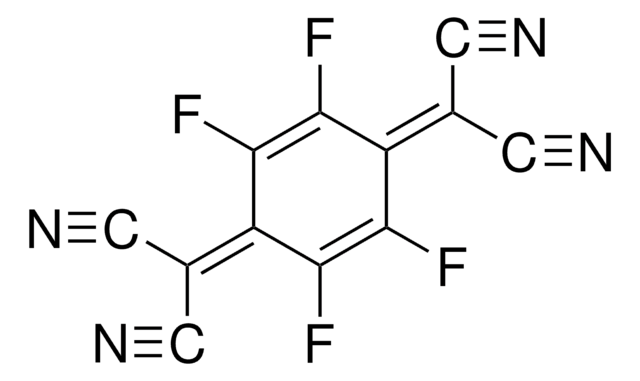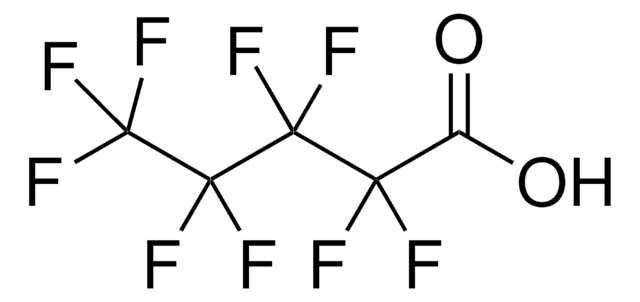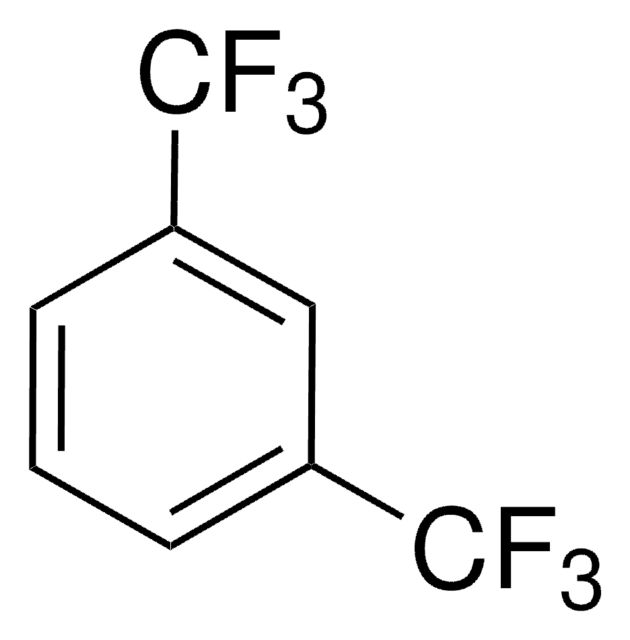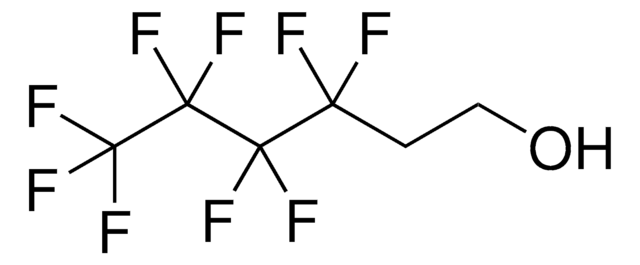Kluczowe dokumenty
446785
Perfluorotetradecanoic acid
96%
Synonim(y):
2,2,3,3,4,4,5,5,6,6,7,7,8,8,9,9,10,10,11,11,12,12,13,13,14,14,14-Heptacosafluorotetradecanoic acid, Perfluoro-n-tetradecanoic acid, Perfluoromyristic acid, Perfluorotetradecanecarboxylic acid
About This Item
Polecane produkty
Poziom jakości
Próba
96%
Formularz
solid
bp
270 °C/740 mmHg (lit.)
mp
130-135 °C (lit.)
grupa funkcyjna
carboxylic acid
fluoro
ciąg SMILES
OC(=O)C(F)(F)C(F)(F)C(F)(F)C(F)(F)C(F)(F)C(F)(F)C(F)(F)C(F)(F)C(F)(F)C(F)(F)C(F)(F)C(F)(F)C(F)(F)F
InChI
1S/C14HF27O2/c15-2(16,1(42)43)3(17,18)4(19,20)5(21,22)6(23,24)7(25,26)8(27,28)9(29,30)10(31,32)11(33,34)12(35,36)13(37,38)14(39,40)41/h(H,42,43)
Klucz InChI
RUDINRUXCKIXAJ-UHFFFAOYSA-N
Szukasz podobnych produktów? Odwiedź Przewodnik dotyczący porównywania produktów
Powiązane kategorie
Zastosowanie
- W bezmetalowej syntezie organicznych jodków przy użyciu N-jodoamidów metodą jododekarboksylacji.
- Do syntezy perfluoromakromolekuł na uwięzi benzimidazolu w reakcji z o-fenylenodiaminą poprzez reakcję kondensacji.
Hasło ostrzegawcze
Danger
Zwroty wskazujące rodzaj zagrożenia
Zwroty wskazujące środki ostrożności
Klasyfikacja zagrożeń
Acute Tox. 4 Inhalation - Acute Tox. 4 Oral - Carc. 2 - Eye Dam. 1 - Lact. - Repr. 1B - STOT RE 1
Organy docelowe
Liver
Kod klasy składowania
6.1C - Combustible acute toxic Cat.3 / toxic compounds or compounds which causing chronic effects
Klasa zagrożenia wodnego (WGK)
WGK 3
Temperatura zapłonu (°F)
Not applicable
Temperatura zapłonu (°C)
Not applicable
Środki ochrony indywidualnej
Eyeshields, Gloves, type N95 (US)
Wykazy regulacyjne
Wykazy regulacyjne dotyczą głównie produktów chemicznych. Można w nich podawać ograniczoną liczbę informacji na temat produktów niechemicznych. Brak wpisu oznacza, że żaden ze składników nie znajduje się w wykazie. Użytkownik odpowiada za zagwarantowanie bezpiecznego i zgodnego z prawem stosowania produktu.
EU REACH SVHC Candidate List
Wybierz jedną z najnowszych wersji:
Masz już ten produkt?
Dokumenty związane z niedawno zakupionymi produktami zostały zamieszczone w Bibliotece dokumentów.
Klienci oglądali również te produkty
Global Trade Item Number
| SKU | GTIN |
|---|---|
| 446785-25G | |
| 446785-5G | 4061832286310 |
Nasz zespół naukowców ma doświadczenie we wszystkich obszarach badań, w tym w naukach przyrodniczych, materiałoznawstwie, syntezie chemicznej, chromatografii, analityce i wielu innych dziedzinach.
Skontaktuj się z zespołem ds. pomocy technicznej








![Dipyrazino[2,3-f:2′,3′-h]quinoxaline-2,3,6,7,10,11-hexacarbonitrile 95% (HPLC)](/deepweb/assets/sigmaaldrich/product/structures/151/558/c0e2c95f-5228-4864-a7a5-4b9765a19840/640/c0e2c95f-5228-4864-a7a5-4b9765a19840.png)






